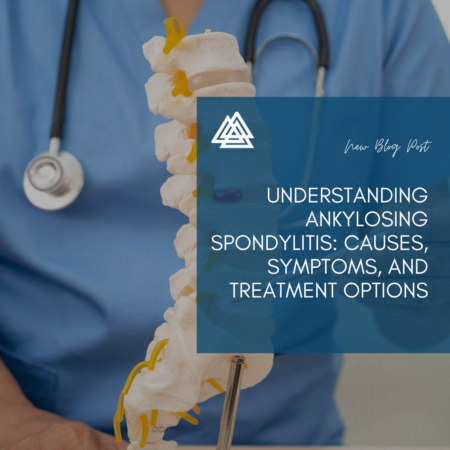 Ankylosing spondylitis (AS) is a chronic inflammatory disease that primarily affects the spine and the sacroiliac joints—the joints connecting the spine to the pelvis. This condition can lead to severe pain and stiffness, significantly impacting an individual’s quality of life. Understanding AS is crucial for those affected and their families, as early diagnosis and effective management can help reduce symptoms and improve mobility. In this blog post, we will explore the causes, symptoms, diagnosis, and treatment options for ankylosing spondylitis.
Ankylosing spondylitis (AS) is a chronic inflammatory disease that primarily affects the spine and the sacroiliac joints—the joints connecting the spine to the pelvis. This condition can lead to severe pain and stiffness, significantly impacting an individual’s quality of life. Understanding AS is crucial for those affected and their families, as early diagnosis and effective management can help reduce symptoms and improve mobility. In this blog post, we will explore the causes, symptoms, diagnosis, and treatment options for ankylosing spondylitis.
What Causes Ankylosing Spondylitis?
The exact cause of ankylosing spondylitis is not entirely understood, but it is believed to be a combination of genetic and environmental factors. Some key points include:
- Genetic Predisposition: A significant number of people with AS carry a specific gene known as HLA-B27. While not everyone with this gene will develop AS, its presence is a strong indicator of susceptibility to the condition.
- Autoimmune Response: AS is considered an autoimmune disease, where the body’s immune system mistakenly attacks healthy cells in the joints and spine, leading to inflammation and pain.
- Environmental Factors: Although the specific triggers for AS are not fully identified, factors such as infections may play a role in initiating the inflammatory response.
Common Symptoms of Ankylosing Spondylitis
The symptoms of ankylosing spondylitis can vary from person to person, but some common signs and symptoms include:
- Chronic Back Pain and Stiffness: This is often the first and most prominent symptom, typically felt in the lower back and buttocks. The pain is usually worse in the morning or after prolonged periods of inactivity.
- Reduced Flexibility: Over time, individuals with AS may experience decreased flexibility in the spine, leading to difficulty bending or twisting.
- Pain in Other Joints: AS can also affect other joints, such as the hips, shoulders, and knees, causing pain and swelling.
- Fatigue: Chronic inflammation can lead to feelings of tiredness and reduced energy levels.
- Eye Inflammation: Some individuals with AS may experience eye problems, such as uveitis or iritis, which can cause redness, pain, and blurred vision.
- Postural Changes: As the condition progresses, the spine may become fused, leading to a stooped posture and a loss of the natural curvature of the spine.
Diagnosis of Ankylosing Spondylitis
Diagnosing ankylosing spondylitis can be challenging, as symptoms may mimic other conditions. Healthcare providers typically use a combination of the following methods for diagnosis:
- Medical History and Physical Examination: A thorough history of symptoms, family history of autoimmune diseases, and a physical examination focusing on spinal mobility and joint pain.
- Imaging Tests: X-rays and MRI scans can help visualize changes in the spine and sacroiliac joints. In the early stages, MRIs may be particularly useful in detecting inflammation that X-rays may not show.
- Blood Tests: Blood tests may be conducted to check for the presence of the HLA-B27 gene and markers of inflammation, such as C-reactive protein (CRP) and erythrocyte sedimentation rate (ESR).
Treatment Options for Ankylosing Spondylitis
While there is no cure for ankylosing spondylitis, various treatment options can help manage symptoms and improve quality of life:
- Medications:
- Nonsteroidal Anti-Inflammatory Drugs (NSAIDs): Over-the-counter NSAIDs, such as ibuprofen or naproxen, can help relieve pain and reduce inflammation.
- Disease-Modifying Antirheumatic Drugs (DMARDs): Medications like sulfasalazine may be prescribed to help slow disease progression, particularly if other joints are affected.
- Biologics: For moderate to severe cases, biologic medications that target specific pathways in the immune system can be highly effective in reducing inflammation and preventing structural damage.
- Physical Therapy: A physical therapist can create a tailored exercise program that focuses on improving flexibility, posture, and strength. Regular exercise is vital for maintaining mobility and reducing stiffness.
- Exercise: Engaging in regular physical activity can help improve spinal flexibility and reduce pain. Low-impact activities such as swimming, walking, and cycling are often recommended.
- Lifestyle Modifications: Maintaining a healthy weight, avoiding smoking, and managing stress through relaxation techniques can also contribute to better symptom management.
- Surgery: In rare cases, surgery may be necessary to correct severe joint damage or deformities that impair mobility.
Living with Ankylosing Spondylitis
Living with ankylosing spondylitis can present challenges, but with appropriate treatment and lifestyle changes, many individuals can lead fulfilling lives. Here are some tips for managing the condition:
- Educate Yourself: Understanding AS and its potential impacts can help you make informed decisions about your treatment and lifestyle.
- Connect with Support Groups: Connecting with others who have AS can provide emotional support, share coping strategies, and offer practical advice.
- Monitor Symptoms: Keep track of your symptoms and discuss any changes with your healthcare provider to adjust your treatment plan as needed.
Conclusion
Ankylosing spondylitis is a chronic condition that can significantly impact daily life, but early diagnosis and a comprehensive management plan can help individuals maintain mobility and improve their quality of life. If you suspect you or a loved one may have AS, seeking medical advice is crucial for effective management. With the right support and treatment, those living with ankylosing spondylitis can lead active, fulfilling lives.
